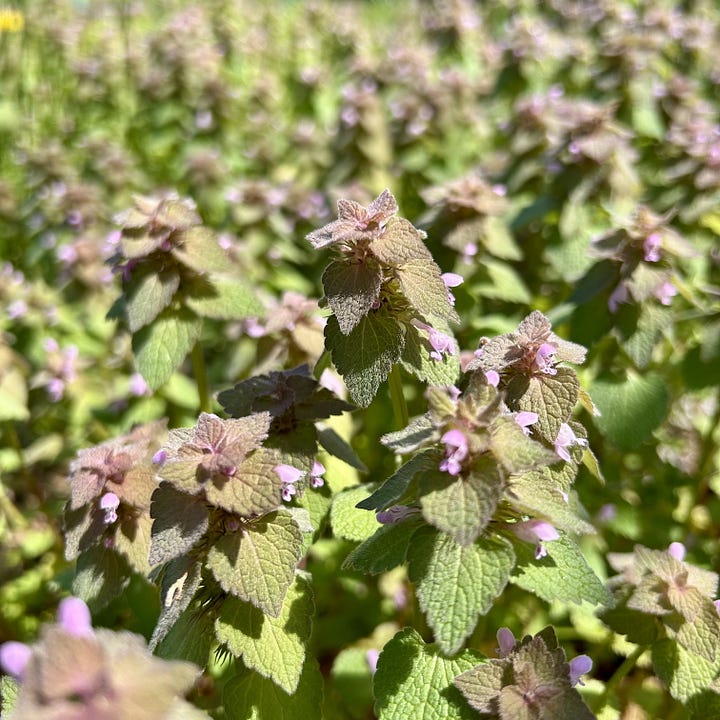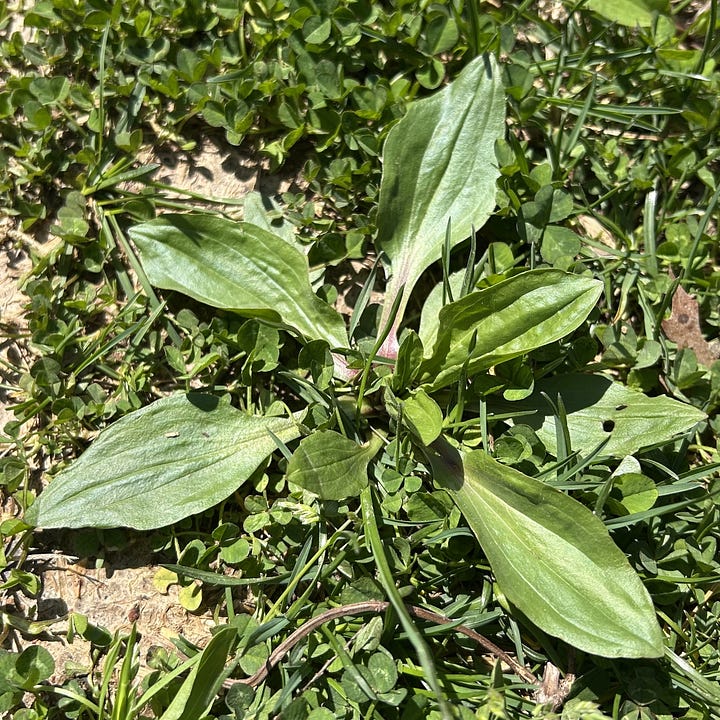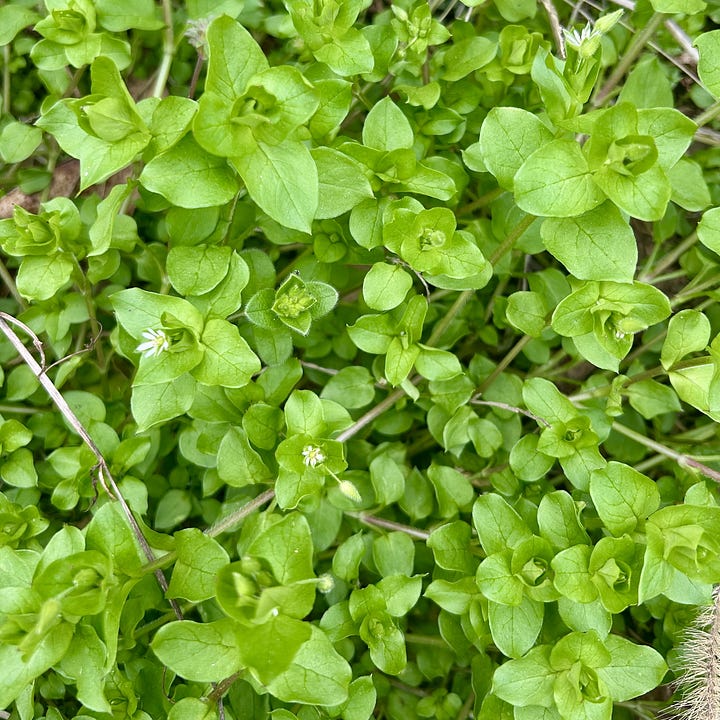April 2025: Weeds, Weeds, Weeds
Straggly leaves and full of seeds.
In this month’s issue:
Tons of weeds are springing up this month — give them a smidgen of credit, OK?
Get your basket because morels are back, baby!
A few recommendations for loud, screeching radios that kick on when twisters are doing their thing.
Plus a few other nature notes.
It’s hard for me to corral writing time once spring arrives. As soon as temperatures hit a solid 50 degrees, I’m outside hunting for mushrooms, watching birds build nests atop my shed, and checking the bat boxes along my house to see if I have new BFFs (best flying friends). I become a lizard woman, soaking up the much-needed sunlight and vitamin D of which I was deprived all winter. And then there’s my begrudging battle with snares of weeds that have taken over my garden.
Those very nuisances heavily inspired this month’s Outdoor Humans. How often have you asked yourself “What is this?” when pulling some scraggly green from a potted plant or crack in a sidewalk. Sometimes I let them stay awhile, unsure if it’s friend or foe, but willing to give that little sprig a chance at survival until I know what I’m working with. On occasion, I’ve been rewarded with native plants that blossom. Other times, I’ve had to cut down thick, woody invasives that rapidly dominated part of the yard, much to my dismay.
This month, I’ve decided to give some of these little plants a second look. The ones we pass by or spray for being a nuisance, even though they’re just out there in nature, doing their own thing. Maybe we have more to learn from them than we think.
A Fresh Look at a Few So-Called “Weeds”
Weeds are a human construct, and you cannot convince me otherwise. In the natural world, every species serves some kind of purpose, though it’s we humans who have taken it upon ourselves to decide if that task is useful to us. You may have heard the famed Ralph Waldo Emerson quote alluding to the same idea:
“What is a weed? A plant whose virtues have not yet been discovered.” 🌼
We silly humans, always centering ourselves as the discoverers, owners, and managers of all things. Even with that self-awareness, I still wonder: What the heck is this plant? Does it do anything? Can I use it for something? (Also: Why is it taking over my entire garden?) Perhaps they aren’t merely scraggly annoyances, but contributing members of plant society, thriving without acknowledgement for their hard work? I guess it just depends on what we consider to be a “weed” and a “useful plant.”
What Makes a Weed?
This month, I challenge you to give weeds a little credit. These plants are actually survivors and adapters. Getting “weed” as a title is something of a badge of honor considering horticulturists require them to have a handful of talents, such as:
Growing and maturing quickly — some would even say aggressively
Adapting to their environment and surviving climate extremes
Thriving in poor conditions where other plants wouldn’t even try
Being prosperous plant parents — some species put off thousands to millions of seeds per plant to give their descendants a chance at survival, and many times they’ll mimic the seeds of favorable plants (tricky tricky)
Developing tools for survival, like having prickly burrs or spines, smelling foul when crushed, or tasking horrible when nibbled
Not every plant has all of these features, but the more it has, the more likely it is to be a weed. Could humans do all of these things? Surely not.
6 Weeds You May Find in Your Own Yard
In just a few minutes outdoors, I was able to spot a handful of weeds — some known to me, others stuck in the “one day I’ll remember to look this up” purgatory of my phone camera roll. You may find these in your backyard, too.


Henbit (Lamium amplexicaule): I love the fluted flowers of henbit, though I’ll admit I’m not a fan of how quickly these plants take over my vegetable beds (each plant can produce upwards of 200 seeds). Henbit is actually a member of the mint family, and while we may not be adding it to a mint julep anytime soon, it does provide nectar and pollen for honeybees and bumblebees.
Purple Deadnettle (Lamium purpureum): Henbit and purple deadnettle are commonly confused, though that’s not entirely our fault considering they’re cousins in the same plant family. Like henbit, pollinators rely on purple deadnettle in early spring when little else is blooming. Perhaps let them both linger a little longer this spring before mowing your yard.


Garlic Mustard (Alliaria petiolata): Garlic Mustard is an invasive herb brought to the U.S. in the 19th century for medicinal use. You can identify it by the heart-shaped leaves that give off a distinct garlic smell when crushed. While you can eat young garlic mustard plants raw, older plants must be cooked because they contain cyanide. Even if you skip harvesting this one, The Nature Conservancy recommends pulling garlic mustard wherever you find it, since this species releases chemicals from its roots that stop trees and other species from growing.
Broadleaf Plantain (Plantago major): It’s not spinach, but it looks similar, doesn’t it? Good thing you can eat broadleaf plantains found in your yard in the exact same way so long as they haven’t been sprayed with pesticides. This large weed also can be used to quell itchy bug bites since the leaves contain anti-inflammatory compounds. Give it a try by rolling a leaf between your hands with a splash of water until it becomes a goopy poultice, then apply to your bite (or make this salve).


Chickweed (Stellaria media): This weed is technically an herb related to carnations. It grows aggressively, spreading a foot wide per plant with small white blooms that later disperse anywhere from 500-3,000 seeds (which is why I can’t seem to get rid of it). Despite this, chickweed does have some perks: it’s leaves and flowers are edible, and it attracts pollinators such as bees, butterflies, and moths.
Dandelion (Taraxacum officinale): Easily recognizable for their buttery yellow cups, you may be wondering why I included dandelions on this list. They are, perhaps, the most obvious of weeds, though it’s only in the past century that humans have decided dandelions have no value. These plants have been used for millennia as medicine, used to remedy everything from baldness to gallbladder issues and toothaches (though research is limited on efficacy). However, you really can eat dandelions — they’re packed with iron, potassium, calcium, and enough vitamin C to treat scurvy.
Let me know in the comments if you’ve ever foraged for some of these “yard weeds” and how you’ve used them. Or, share your favorite aggrieved weed and how you came to befriend it.
Head to the woods, it’s fungi time. Morel mushrooms are popping up this time of year. These little delectable fungi love the warm, wet weather ushered in by spring. Check out my quick-start guide to finding morels this spring.
Scrub and fill your hummingbird feeders. These solo travelers have begun their return trips, and typically arrive in the U.S. between mid-April and early May. Here’s how you can attract these frenzied feeders to your yard.
Celebrate Earth Day on April 22. This year marks the 55th anniversary of an eco-movement that pushed forward the creation of the Environmental Protection Agency, the Clean Air Act, and other legislation. Honor the day by picking up trash on a walk or hike, making a sustainable swap, or contacting your legislator about recent changes and attacks on environmental protections.
🐌 Hold the salt, the snails are out. North America is home to hundreds of land snail species — just a fraction of the 30,000+ species found worldwide. These slow movers are weather sensitive, hiding away during frigid winters and the hottest days of summer, meaning April is peak slime season. Snails are often overlooked yet intriguing ecosystem crew members. They eat rotting vegetation and help return nutrients to the soil as they burrow. They’re also food for some omnivores, though if they escape that fate, wild snails can live up to seven years.
💃🏼 April is prom season, and even the dragonflies are showing up to dance. Some species enter the skies this month after spending upwards of five years moving from egg to nymph and eventually an adult flyer. Like awkward teenagers in a decorated gym, dragonflies also dance as part of their socializing process, though it’s a high-stakes hustle. Males will enter acrobatic dance battles over ponds and lakes that end only when one runs out of energy and crashes from the sky, falling down dead into the water. The winner gets the girl — unless another onlooking male has caught her attention from the sidelines.
🌕 When the moon climbs up high in the mid-April sky… that’s a Pink Moon. The first full moon following the vernal equinox goes by many names — Pink Moon, Pink Phlox Moon, Budding Moon, Growing Moon, you get the drift — but to be clear, it won’t actually have a rosy hue. However, this month’s full moon will be a micromoon, a phenomenon that occurs when the moon reaches its fullest phase while also at the farthest point in its orbit from Earth. Look out for this lil guy on April 12.
It’s Tornado Season, Y’all (But You Midwesterns Already Know That)
I’ve lived in the Midwest my entire life and experienced my fair share of tornado close-calls. At this point, rough spring weather doesn’t scare me, however I do recognize our changing climate is fueling nastier storms. The timing, intensity, and longevity of recent tornado seasons — along with a wave of federal firings of NOAA and NWS meteorologists and staffers — has pushed me to dedicate the time to emergency preparedness.
The internet is packed with guides for building your own disaster response kit — I’m not going to get into those details because there are too many factors at play. However, I do want to leave a few recommendations for emergency radios that have saved my biscuits while at home and out in the woods. Shopping for emergency gear is expensive and gives me massive decision fatigue, so I hope these recommendations help if you’re in the market for a new weather band radio.
📻 My Favorite At-Home Choice: Eton American Red Cross FRX3
After college, I moved to southwest Missouri, just north of Joplin. Yes, that Joplin, the one that experienced a devastating EF5 tornado in 2011. My parents gifted me an earlier model of this emergency radio on the heels of that disaster, and it was well-used for years. It was a workhorse that didn’t require being plugged in, and had backup battery, handcrank, and solar power options. Other perks: it was easy to program, had a built-in flashlight, phone-charging ports, and a grab handle that came in handy while dashing to my safety spot. This weather radio took a beating and lasted about 10 years (thanks mom and dad!) before I ended up replacing it with a newer Midland model that has done nothing but disappoint me.
📻 What I Keep in My Camper: Kaito KA380 Radio
I snapped up this handy palm-sized emergency radio while stocking my camper two summers ago, and it came in handy weeks later when severe storms interrupted a trip in South Dakota’s Black Hills. Was I initially a sucker for how cute this radio is? Absolutely. But I’ve also been really impressed with all the features packed into this compact radio. You can easily switch between battery, crank, or solar power. The weather dial tunes into warnings with crisp and clear sound, and the “standby” feature is helpful when you know there’s a possibility of rough weather that day, but you’re busy making s’mores (the radio stays silent in the background and kicks on when a weather alert comes through). You can also charge your phone from this radio or use it as a flashlight, and the handy strap on the back means you can set or hang it anywhere.
Even if you choose a different model, the most important, regardless of where you live, is to have access to weather and emergency information apart from your phone. Sure, it’s old school technology, but it works when cell towers go down and you’re cranky from sitting in the dark with no internet access.
That’s it for this month’s edition of Outdoor Humans. Keep your wits about you, and go the heck outside.
Nicole Garner Meeker
Have a nature question?
Your inquiry may be published and answered in a future
issue of Outdoor Humans. Have you subscribed? Clickety click, my friend.
Or, share with a friend who needs to go outside and touch grass.Art notes: This month’s feature art includes images from La plante et ses applications ornementales (1896) by Eugène Grasset.










Love this post. A wonderful family friend I grew up with grew up on a farm, had a big garden and a front and back yard with lots of Dandelions. She was so kind and like a neighborhood Auntie, she lived a few doors down from my Granny.
I was one of the kids who liked to visit with her and be one of her helpers. Many times I helped her pick Dandelion so she could make Dandelion greens. She put them in soups and she knew a lot about plants, she grew up on a farm in Danville, Illinois.
She would tell me how people look at her yard and see weeds but she saw good things to eat.